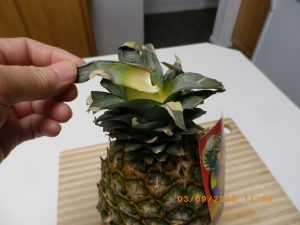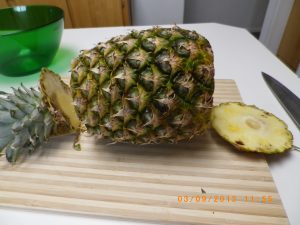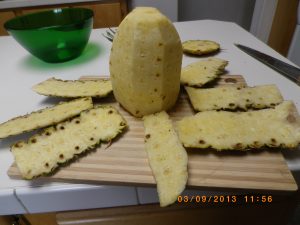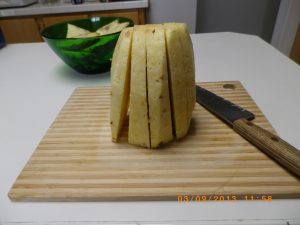Table of Contents
Product of the Month: Pineapple
Alias Names: Ananas, Nanas, Pina.
The Scientific name for the pineapple is Ananas comosus. Ananas comes from the Tupi word meaning “excellent fruit” and the word pineapple was coined because it looks like a pine cone (so, what’s with the apple part then?) Anyway, pineapples are second only to bananas as America’s favorite tropical fruit. Although the season for pineapple runs from March through June, they are available year-round in local markets.
History: Pineapples were originally discovered in South Africa as an indigenous plant. From there it traveled to the Caribbean, Hawaii, southern California, Guam, Thailand the Philippines and Christopher Columbus brought some of the plants back to Europe. Southeast Asia currently dominates the world in pineapple production producing almost 2 million tons of pineapple each year.
Uses: Pineapples are consumed both fresh and cooked, canned, or juiced, and are found in a wide array of cuisines including dessert, fruit salad, jam, yogurt, ice cream and candy—and as a complement to meat dishes. The juice can be used as a meat marinade, but you can’t use the fresh juice to make jelly or Jell-O because it won’t set up. Processing the juice kills these enzymes. In the Philippines the leaves of pineapple are used as a textile fiber for making wallpaper.
Nutritional Benefits of Pineapple: One cup of pineapple has 82 calories and provides the following nutrients—many of which act as natural antioxidants to help in the prevention of oodles of diseases:
- Calcium
- Copper (9% of the body’s daily need)
- Fiber (9.2%)
- Folate (7.4%)
- Manganese (76.5%) –read more on manganese here: https://naturalhealthtechniques.com/diet_nutritionmanganese.htm
- Potassium
- Thiamine (Vitamin B1) 18.6%
- Vitamin B6 (Pyridoxine) 18.6%
- Vitamin C (131.4%) Maybe this is why pineapple is so good for smokers’ lung issues.
Raw pineapple is also abundant in the proteolytic enzyme bromelain, found mostly in the stem and fruit. Bromelain breaks down protein. So, for those of you who eat too much meat and suffer from indigestion afterwards, (especially you blood type A people) pineapple and supplements including bromelain would be a logical addition to your daily regime of supplements.
The Following are the Benefits of Pineapple:
- Dissolves mucous
- Facilitates good digestion
- Fights cough and colds
- Helps colitis
- Helps fight inflammation
- Helps overcome sinusitis
- Helps prevent morning sickness
- Helps prevent production of tooth plaque
- Inhibits tumor growth
- May help prevent formation of blood clots
- Protects against macular degeneration
- Provides energy
- Strengthens bones
- Strengthens the immune system
In Germany, bromelain is approved as a post-injury medication because of its ability to reduce inflammation and swelling. In Europe pineapple is used post-operatively to cut mucous after sinus and throat operations.
What is Bromelain? Bromelain is a complex mixture of substances (called cysteine proteinases) that can are extracted from the stem and core of pineapple but there are slight differences in the stem vs. the core enzyme structures. These substances are what are responsible for the wide variety of health benefits derived from pineapple. OK, so maybe we should chew more on the pineapple core instead of throwing it away!
Protection against Macular Degeneration: In a study involving over 110,000 women and men published in the Archives of Ophthalmology results indicated that eating three or more servings of fruit per day may lower your risk of age-related macular degeneration (ARMD), the primary cause of vision loss in older adults, by 36%, compared to persons who consume less than 1.5 servings of fruit daily.
How to Choose and Cut a Pineapple:
- Pulling the center leaf out of the pineapple to test for ripeness.
- Look for pineapples that are heavy for their size.
- Pineapples should be free of soft spots, bruises and darkened “eyes,” all of which may indicate that the pineapple is past its prime.
- Pineapple stops ripening as soon as it is picked, so choose fruit with a fragrant sweet smell at the stem end.
- The area closer to the base of the fruit has more sugar content so is sweeter and more tender.
- Avoid pineapple that smells musty, sour or fermented.
- Color may not be a good indicator of ripeness as the pineapples are exposed to chemicals which convert to ethylene which ripens them in a warehouse somewhere.
- I’ve had good luck with pulling out the center leaf. If it pulls out easily with a gentle tug, you’re probably going to get a great tasting, sweet pineapple (although I noticed someone had pulled the center leaves out of a whole table of pineapples on purpose at the grocery store the other day and none of them were ripe. It’s a gentle tug, not a yank! They even put the leaf back so the next person would be fooled!)
- For the most antioxidants, choose fully ripened pineapple.
- Leaving the pineapple at above 45 degrees and above (or room temperature) for a day or two will make it softer and more juicy but not any sweeter.
- Kept in the refrigerator, a pineapple can keep for up to a week (I’ve read several different time periods but they ranged from 3-10 days.)
- Pineapple that has been cut up should be stored in the refrigerator in an airtight container to protect it from oxidizing and to keep the enzymes working as optimally as possible.
- Freezing pineapple greatly affects its flavor.
- As with many fruits and vegetables, pineapples are sprayed with chemicals to protect them from pests and to turn them yellow after being picked. I wipe off the cutting board after cutting off the skin and before cutting the fruit into chunks so that any chemicals won’t contact the flesh.
Now let’s cut one of those babies up, shall we?
Step 1: First, chop off the top and the bottom. Either plant the top or toss it into the garbage. It takes forever for the top to compost.
Step 2: Cut off the skin. Toss the bottom, skin, and core onto the compost pile fruit side up for the birds.
Step 3: Cut slabs of flesh from the center core. You’ll toss the core and cut the slabs into chunks.
Step 4: Cut slabs into chunks, eat it and/or package up the chunks in an airtight container. We use glass because the pineapple can pick up the flavor from plastic or metal containers.
Pineapple’s effects on inducing pregnancy: Pineapple is not thought to induce labor, but rather is thought to act as a cervical ripening agent that stimulates prostaglandin production (this has not scientifically proven.) Some women have sworn by this though. Reference: https://www.givingbirthnaturally.com/foods-that-induce-labor.html
Allergies: Pineapple is not a commonly allergenic food, is not known to contain measurable amounts of oxalates or purines and is also not included in the Environmental Working Group’s 2010 report “Pesticides in Produce” as one of the 12 foods most frequently containing pesticide residues. In fact, pineapple is often used as a fruit in allergy avoidance diets partly for these reasons, and for its bromelain (digestive enzyme) component.
What if eating pineapple makes your tongue hurt? Chinese people dip the pineapple in salty water for a few seconds. It neutralizes the tingling on the tongue that you otherwise get. (Thanks to one of my Facebook friends for sharing that information.)
The Pineapple Fast for Parasites: https://www.wikihow.com/Do-a-Pineapple-Fast-for-the-Lungs
From their website: “Whether you want to restore elasticity of your lungs, ward off parasites or just detoxify, a pineapple fast may be what your body craves. Pineapple helps clean lungs naturally, in part because it contains the enzyme bromelain.” They go on to say how the bromelain somehow magically realizes that the parasite is foreign and dissolves both the parasite and the larvae. Gee, if it does that to living things, how would it know not to dissolve other living/healthy tissue? This doesn’t make sense, so I would not assume that pineapple kills parasites. Actually I think that bromelain focuses on dead proteins. Sorry to be the bearer of skepticism here. Just my scientific mind working.
How to grow a pineapple: Pineapple is an herbaceous perennial which grows best in tropical zones 8-10 but can handle temperatures as low as 28 degrees for short periods of time. Prolonged cold retards growth, delays maturity and causes the fruit to be more acid. Pineapples produce under a wide range of precipitation ranging from 25 – 150 inches, depending on variety, location and degree of humidity. They are successfully grown in southern Florida and coastal areas of southern California. The small plant adapts well to container and greenhouse gardening and makes an interesting potted plant.
An adult pineapple reaches the height of 2-1/2 to 5 feet tall with a spread of 3-4 feet. Pineapple plants like well-drained, sandy loam, acid soil (pH4.5-6.5) with high organic content and they don’t like a lot of watering. You can make the soil more acidic with the same products you would use to plant hydrangeas and blueberries (often sulfur-which is not good for people allergic to sulfur and sulfites by the way).
Pineapple can be grown as a house plant by cutting or twisting the top off the pineapple before cutting it up to eat, letting it dry on the counter for two days, then either sticking the top into some soil or starting it in a shallow dish of water (like you would a carrot) and a new plant will grow. Slips and suckers are the chosen part of the plant when used in commercial operations.
It takes about two years for the pineapple plant to produce about 200 lavender, purple or red flowers (depending on the variety). These flowers coalesce together to form the pineapple that is harvested. When grown commercially, the pineapples are picked before they can be pollinated by hummingbirds or bats which stimulate the plant to produce dark, very hard seeds. Like broccoli, the main flower (pineapple) is harvested before the flowers open. Suckers form around the biggest pineapple at its base. These are broken off and used as starts to produce more pineapple plants.
Pineapples starts are planted outside during the summer months. A ground cover of black plastic is commonly used, both as protection from weeds and for the extra heat the plastic seems to absorb. Black plastic also helps to conserve moisture. Plants are spaced 12 inches apart, crowns about 2 inches deep and suckers and slips 3 to 4 inches deep. The plants usually produce for about four years.
The ripe flesh ranges from nearly white to yellow. The fruit grow to twelve inches tall and can weight from 1-10 pounds when fully ripe. Ten pounds. . .can you imagine?
Pests of the pineapple plant include mealy bugs (they cause wilt), scale, mites, ants, bacteria and at least one virus.
Helpful Links and References for Pineapple:
- All about Pineapple: https://en.wikipedia.org/wiki/Pineapple
- How to pick a great piece of fruit: https://naturalhealthtechniques.com/diet_nutritionhowtochoosebestfruit-htm.htm
- Health benefits of Pineapple:https://healthfoodbenefits.com/superfoods-benefits/pineapple-benefits.html




